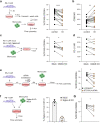Pancreatic cancer-associated fibroblasts modulate macrophage differentiation via sialic acid-Siglec interactions
- PMID: 38594506
- PMCID: PMC11003967
- DOI: 10.1038/s42003-024-06087-8
Pancreatic cancer-associated fibroblasts modulate macrophage differentiation via sialic acid-Siglec interactions
Abstract
Despite recent advances in cancer immunotherapy, pancreatic ductal adenocarcinoma (PDAC) remains unresponsive due to an immunosuppressive tumor microenvironment, which is characterized by the abundance of cancer-associated fibroblasts (CAFs). Once identified, CAF-mediated immune inhibitory mechanisms could be exploited for cancer immunotherapy. Siglec receptors are increasingly recognized as immune checkpoints, and their ligands, sialic acids, are known to be overexpressed by cancer cells. Here, we unveil a previously unrecognized role of sialic acid-containing glycans on PDAC CAFs as crucial modulators of myeloid cells. Using multiplex immunohistochemistry and transcriptomics, we show that PDAC stroma is enriched in sialic acid-containing glycans compared to tumor cells and normal fibroblasts, and characterized by ST3GAL4 expression. We demonstrate that sialic acids on CAF cell lines serve as ligands for Siglec-7, -9, -10 and -15, distinct from the ligands on tumor cells, and that these receptors are found on myeloid cells in the stroma of PDAC biopsies. Furthermore, we show that CAFs drive the differentiation of monocytes to immunosuppressive tumor-associated macrophages in vitro, and that CAF sialylation plays a dominant role in this process compared to tumor cell sialylation. Collectively, our findings unravel sialic acids as a mechanism of CAF-mediated immunomodulation, which may provide targets for immunotherapy in PDAC.
© 2024. The Author(s).
Conflict of interest statement
The authors declare no competing interests
Figures






References
Publication types
MeSH terms
Substances
LinkOut - more resources
Full Text Sources
Medical
Research Materials

